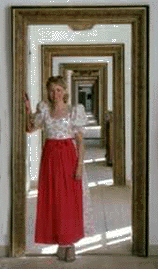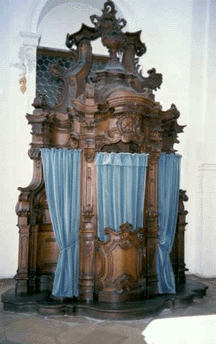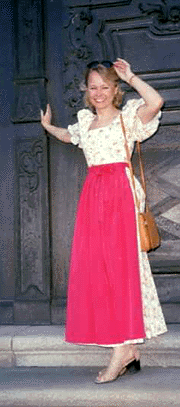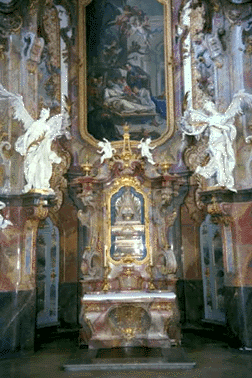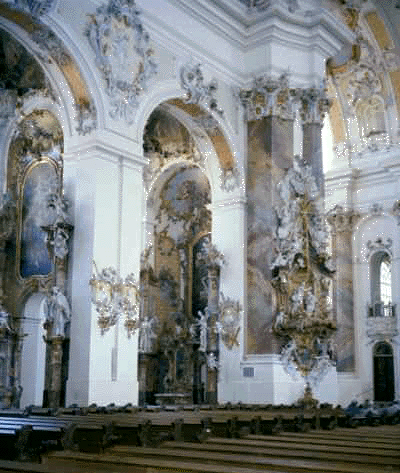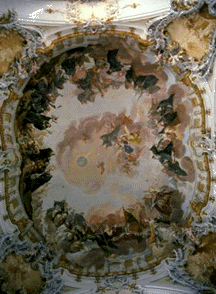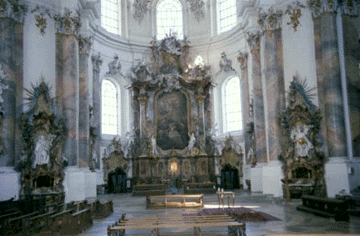Caring for the Mind
There's more to do and see than we can keep up with.
Verdi's Ein Maskenball was this year's operetta.
The Vienna Philharmonic performs from under the massive stage.
We are renting the apartment used by the King--the lead role.
We haven't missed a Festspiele in over a decade now.
We've watched Russian ballet, listened to the Kosak men's choir, attended the Chinese circus (well, its
culture to me), and enjoyed a Glenn Miller's Band concert. Unfortunately, we videotaped most of this
stuff and can't put it on this website.
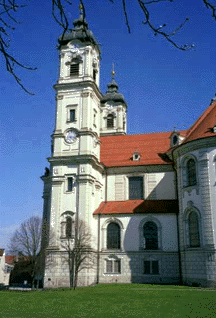 But I did manage to smuggle a camera into a Benedictine cloister and basilica that our great friend Henry Stern
recommended. Ottobeuren is only forty miles or so from Bregenz, situated in bucolic southern
Germany. Most examples of baroque architecture are relatively small because there is so much painstaking
detail. But Henry said he liked my description of Ottobeuren as "miles of detail."
But I did manage to smuggle a camera into a Benedictine cloister and basilica that our great friend Henry Stern
recommended. Ottobeuren is only forty miles or so from Bregenz, situated in bucolic southern
Germany. Most examples of baroque architecture are relatively small because there is so much painstaking
detail. But Henry said he liked my description of Ottobeuren as "miles of detail."
The church itself was founded in 764, and we could find nothing that was dated as late as the American
Revolution.
You would think that as an analytical "physics" sort I might not enjoy beautiful architecture and
historical items as much as, say, an artist or a musician. I can't say how much an artist might enjoy
Ottobeuren, but places like this allow me to combine many interests. For example: There was one painting in
particular--"The Vision of St. Hildegaard"--that showed a narrow beam of light
coming through a fissure in a cloudy sky. The light was reflected off a mirror
held by an angel onto the bodice of a gown presumably worn by Hildegaard. The
light was again reflected from the fabric only to eventually dissipate into thin
air several yards in front of her. The angles of incidence and reflection were
perfect, and the beam of light showed its energy in little "puffs" where the
beam encountered glass or fabric. It was grand! Painted ca. mid 16th
century.
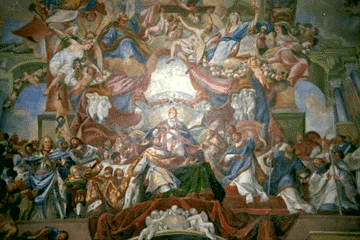
I was captivated by an astronomical clock encased in a huge housing of marble that through the
use of multiple hands, all originating from the center of the face like modern
hour, minute and second hands, that showed the year, the month (and
simultaneously the current sign of the zodiac), the week, the "intersection" of
the sun and the moon (and therefore, the phases of the moon), and of course the
hours and minutes of the day. I could see no way that such a clock could be
designed and built without the certain knowledge that ours is a heliocentric
system. The clock was built in 1524 and functions perfectly to this day, its
massive works powering the graceful hands.
I was amazed by paintings of distinctly modern style that were painted in the 15th and 16th
centuries. Since I was alone and could get away with it--it was a weekday--I
hefted the great broadswords and pikes used in battle and in dress. I saw
perspectives in wood carvings that would not appear for another 300 years in
paintings. It is clear that different artistic styles often appear much earlier
than our textbooks lead us to believe, probably because the early examples
simply didn't "catch on" for awhile, so there was no "school" of that particular
style and therefore no patronage of those innovative artists.
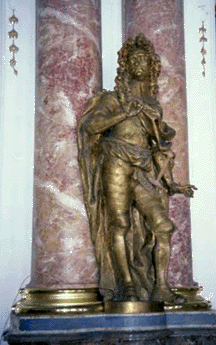 The Hall of Kings, filled with statues sculpted before
the signing of the Declaration of Independence, portrayed the upper classes of the day as unbelievably
effete, dissociated figures whose most important task was to examine their nails in disinterested fashion.
These guys were prancing and posing in ways that would make any gay bar hum.
The Hall of Kings, filled with statues sculpted before
the signing of the Declaration of Independence, portrayed the upper classes of the day as unbelievably
effete, dissociated figures whose most important task was to examine their nails in disinterested fashion.
These guys were prancing and posing in ways that would make any gay bar hum.
 This
is a marvelous place to spend some time. The tapestry of history is
incredibly rich here and open to all who care to learn from it. No ropes or
rails separate the viewer from the centuries represented by the art of the day.
This
is a marvelous place to spend some time. The tapestry of history is
incredibly rich here and open to all who care to learn from it. No ropes or
rails separate the viewer from the centuries represented by the art of the day.
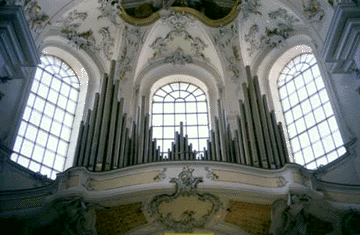
What
powered these great pipes? Some of them are a foot in diameter, with
openings three or more inches wide. That takes a puff of air! Where did it
come from? This particular organ, "The Organ of the Holy Ghost,"--I didn't make that up--was built ca. 1700,
so I'm pretty sure it didn't have access to its own nuclear power plant.
 But I did manage to smuggle a camera into a Benedictine cloister and basilica that our great friend Henry Stern
recommended. Ottobeuren is only forty miles or so from Bregenz, situated in bucolic southern
Germany. Most examples of baroque architecture are relatively small because there is so much painstaking
detail. But Henry said he liked my description of Ottobeuren as "miles of detail."
But I did manage to smuggle a camera into a Benedictine cloister and basilica that our great friend Henry Stern
recommended. Ottobeuren is only forty miles or so from Bregenz, situated in bucolic southern
Germany. Most examples of baroque architecture are relatively small because there is so much painstaking
detail. But Henry said he liked my description of Ottobeuren as "miles of detail."

 The Hall of Kings, filled with statues sculpted before
the signing of the Declaration of Independence, portrayed the upper classes of the day as unbelievably
effete, dissociated figures whose most important task was to examine their nails in disinterested fashion.
These guys were prancing and posing in ways that would make any gay bar hum.
The Hall of Kings, filled with statues sculpted before
the signing of the Declaration of Independence, portrayed the upper classes of the day as unbelievably
effete, dissociated figures whose most important task was to examine their nails in disinterested fashion.
These guys were prancing and posing in ways that would make any gay bar hum.
 This
is a marvelous place to spend some time. The tapestry of history is
incredibly rich here and open to all who care to learn from it. No ropes or
rails separate the viewer from the centuries represented by the art of the day.
This
is a marvelous place to spend some time. The tapestry of history is
incredibly rich here and open to all who care to learn from it. No ropes or
rails separate the viewer from the centuries represented by the art of the day.

